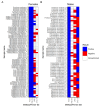Application of Loop-Mediated Isothermal Amplification (LAMP) in Sex Identification of Parrots Bred in Egypt
- PMID: 35453764
- PMCID: PMC9029760
- DOI: 10.3390/biology11040565
Application of Loop-Mediated Isothermal Amplification (LAMP) in Sex Identification of Parrots Bred in Egypt
Abstract
Over 400 of the 3800 tropical avian species are endangered or threatened. One of many solutions to conserve animal biodiversity is breeding animals in zoos or private animal farms. Animal breeding programs are difficult to implement in species with sexual monomorphism, such as parrots. Molecular biology methods offer a solution to determine the sex of these species. Therefore, in this study, we aimed to test the performance of PCR and LAMP techniques on sex identification for 21 parrot species belonging to three families, i.e., Psittacidae, Cacatuidae, and Psittaculidae. We established a protocol for DNA isolation from feathers in our laboratory and found optimal conditions for PCR and LAMP. We showed that the LAMP method with the use of the PSI-W primers set, developed by Centeno-Cuadros, functions in 17 previously untested species. Moreover, we found that further improvements are required in universal LAMP primers for the detection of parrot DNA, which are necessary for confirmation of the male sex. The LAMP method also proved to be more sensitive for female sex identification in contrast to the reference PCR test. Therefore, we conclude that LAMP is a suitable method for the routine diagnostic sex identification of parrots.
Keywords: LAMP; PCR; loop-mediated isothermal amplification; noninvasive; parrots; sex determination.
Conflict of interest statement
The authors declare no conflict of interest.
Figures



Similar articles
-
Validation of loop-mediated isothermal amplification for fast and portable sex determination across the phylogeny of birds.Mol Ecol Resour. 2018 Mar;18(2):251-263. doi: 10.1111/1755-0998.12732. Epub 2017 Nov 20. Mol Ecol Resour. 2018. PMID: 29091348
-
Optimization and application of loop-mediated isothermal amplification technique for sex identification in red-whiskered bulbul (Pycnonotus jocosus).Ecol Evol. 2022 Oct 5;12(10):e9401. doi: 10.1002/ece3.9401. eCollection 2022 Oct. Ecol Evol. 2022. PMID: 36225838 Free PMC article.
-
DNA amplification in the field: move over PCR, here comes LAMP.Mol Ecol Resour. 2017 Mar;17(2):138-141. doi: 10.1111/1755-0998.12548. Mol Ecol Resour. 2017. PMID: 28211246
-
Loop-mediated isothermal amplification of DNA (LAMP): a new diagnostic tool lights the world of diagnosis of animal and human pathogens: a review.Pak J Biol Sci. 2014 Jan 15;17(2):151-66. doi: 10.3923/pjbs.2014.151.166. Pak J Biol Sci. 2014. PMID: 24783797 Review.
-
A Label-Based Polymer Nanoparticles Biosensor Combined with Loop-Mediated Isothermal Amplification for Rapid, Sensitive, and Highly Specific Identification of Brucella abortus.Front Bioeng Biotechnol. 2021 Nov 18;9:758564. doi: 10.3389/fbioe.2021.758564. eCollection 2021. Front Bioeng Biotechnol. 2021. PMID: 34869267 Free PMC article. Review.
Cited by
-
High-Performance PCR for Alleles Discrimination of Chromo-Helicase-DNA Binding Protein (CHD1) Gene in Bird Sexing.Biology (Basel). 2023 Feb 14;12(2):300. doi: 10.3390/biology12020300. Biology (Basel). 2023. PMID: 36829577 Free PMC article.
-
Molecular Determination of Sex from Down and Feather in Wild and Reared Monomorphic and Dimorphic Birds at Juvenile Age.Animals (Basel). 2025 Mar 20;15(6):892. doi: 10.3390/ani15060892. Animals (Basel). 2025. PMID: 40150421 Free PMC article.
References
-
- Díaz Casana C.F., Vivas Ruíz D.E., Sandoval Peña G.A., Chimoy Effio P.J. Molecular Sexing of the White-Winged Guan (Penelope albipennis) and Other Wild Birds of the North of Peru. Sex. Dev. Genet. Mol. Biol. Evol. Endocrinol. Embryol. Pathol. Sex Determ. Differ. 2019;13:47–54. doi: 10.1159/000495383. - DOI - PubMed
-
- Olah G., Butchart SH M., Symes A., Guzmán I.M., Cunningham R., Brightsmith D.J., Heinsohn R. Ecological and socio-economic factors affecting extinction risk in parrots. Biodivers. Conserv. 2016;25:205–223. doi: 10.1007/s10531-015-1036-z. - DOI
-
- Snyder N., McGowan PJ K., Gilardi J., Grajal A. Parrots: Status Survey and Conservation Action Plan 2000–2004. IUCN; Gland, Switzerland: 2000. [(accessed on 10 January 2021)]. Available online: https://portals.iucn.org/library/node/7687.
-
- Cerit H., Avanus K. Sex determination by CHDW and CHDZ genes of avian sex chromosomes in Nymphicus hollandicus. [(accessed on 10 January 2021)];Turk. J. Vet. Anim. Sci. (Turk.) 2008 31:371–374. Available online: https://agris.fao.org/agris-search/search.do?recordID=TR2010000804.
LinkOut - more resources
Full Text Sources

